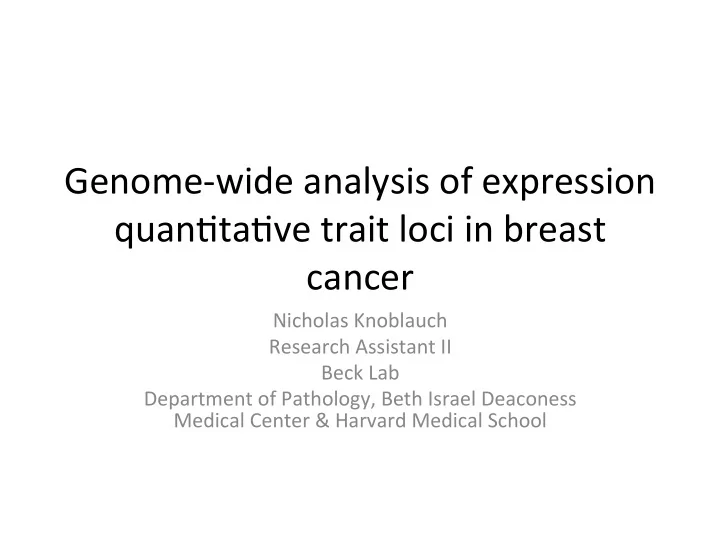

Genome-‑wide analysis of expression quanMtaMve trait ¡loci in breast ¡ cancer Nicholas Knoblauch Research Assistant ¡II Beck Lab Department ¡of Pathology, Beth Israel Deaconess Medical Center & Harvard Medical School
IntroducMon Genotype Phenotype
IntroducMon (Breast ¡Cancer) (Germline) ¡ Genotype Phenotype
Genotype Phenotype
Breast ¡Cancer GWAS • A number of SNPs are associated with increased risk of Breast ¡cancer – ~ 50 in GWAS catalog • How do we infer the mechanism of these risk alleles? – How do we study the funcMonal consequences of variaMon at these loci?
Gene Expression as a phenotype • Easy to measure tens of thousands of features simultaneously • Facilitates invesMgaMon of funcMonal the consequences ¡of geneMc variance
Germline ¡ Genotype ¡ eQTL Analysis ER ¡ Tumor ¡ Gene ¡ status Expression ¡
Data ¡ • 382 TCGA invasive breast ¡cancer cases • Germline SNP data ¡from Affymetrix 6.0 SNP • Expression from Agilent ¡G4502A 244k Array • Imputed SNP data ¡ – ~ 8 million SNPs
~1M ¡SNPs ~8M ¡SNPs • ImputaMon – EsMmate genotype for ungenotyped markers using a genotyped reference panel – BEAGLE ¡ • Infers haplotypes for unrelated individuals – minimac • Low memory footprint ¡ • Implements MaCH ¡algorithm – 906600 SNPs ¡ – 1000G (Nov 2010) for imputaMon
EIGENSTRAT Analysis (PC1 vs. PC2) Genetically estimated White 577 Asian 42 Black 46 -------------- Total 665
Linear Model g = α + γ x + β s + ε • Parameters for intercept,genotype and covariate (ER ¡status) • MatrixEQTL Tests each SNP-‑transcript ¡pair – “Ultra-‑fast” – • ~2 days with 70GB RAM ¡
Results • Of ~8 million SNPs: –~ 140,000 SNP are eQTL – None of 51 known breast ¡cancer risk alleles were detected as eQTL at the given significance threshold
Risk Alleles and eQTL Not Risk ¡ Is a Risk ¡ Allele Allele Not eQTL 7880425 53 Is an eQTL 138138 0 Χ 2 =0.1901, p=0.6628
eQTL Network • Loci -‑> ¡Transcripts • In-‑degree • Out-‑degree • ConnecMvity
In-‑Degree DistribuMon
Out-‑Degree DistribuMon
QTs with highest ¡in-‑degree Gene ¡ In-‑degree ¡ Descrip;on ¡ TSSK1B ¡ 4446 tesMs-‑specific serine kinase CYB5A 3142 Cytochrome b5 type A DPF3 ¡ 2794 Zinc Finger Protein PRL 2354 ProlacMn MEN1 2156 mulMple ¡endocrine ¡ neoplasia CSH1 2120 chorionic ¡ somatomammotropin hormone 1 (placental lactogen) ¡
“ER-‑dimorphic” eQTL • 32 eQTL with opposite t-‑staMsMc in ER+ ¡and ER-‑ cases. Gene ¡ Descrip;on ¡ CD5L inhibitor of apoptosis C19orf6(membralin) ¡ Tumor-‑associated protein MUC4 inhibitor of apoptosis SPATA19 Spermiogenesis IGF1R ¡ anM-‑apoptoMc agent ¡by enhancing cell survival H2AFB3 Atypical histone H2A which can replace convenMonal H2A in some nucleosomes ¡
Conclusions • Of 1,253,331,753,741 SNP-‑transcript ¡ interacMons, 375,127 eQTL were found • Risk allele status does not ¡predict ¡eQTL status • ER ¡status can interact ¡with direcMon of eQTL • Germline genotype can lend insight ¡into Breast ¡cancer phenotype
Acknowledgements • AdiM Hazra • Pete Kra? • John Quackenbush • Constance Chen • Andrew ¡Beck
Recommend
More recommend